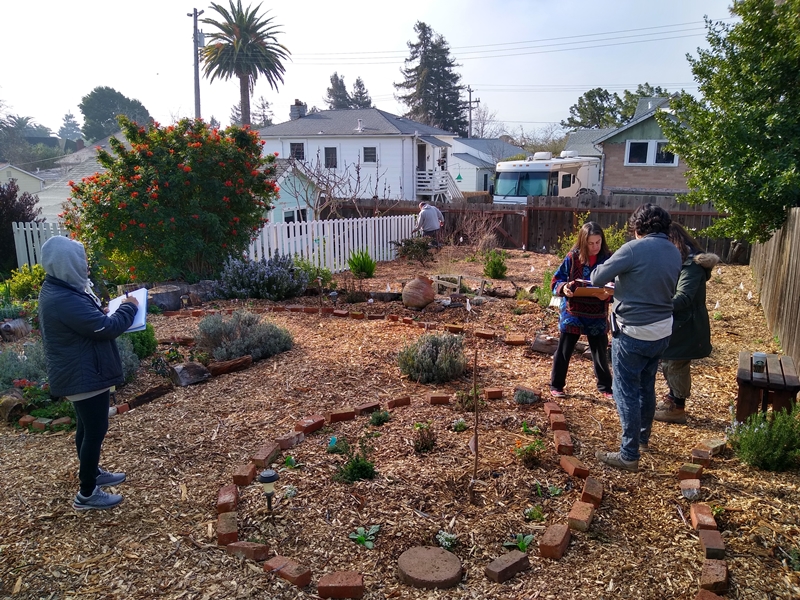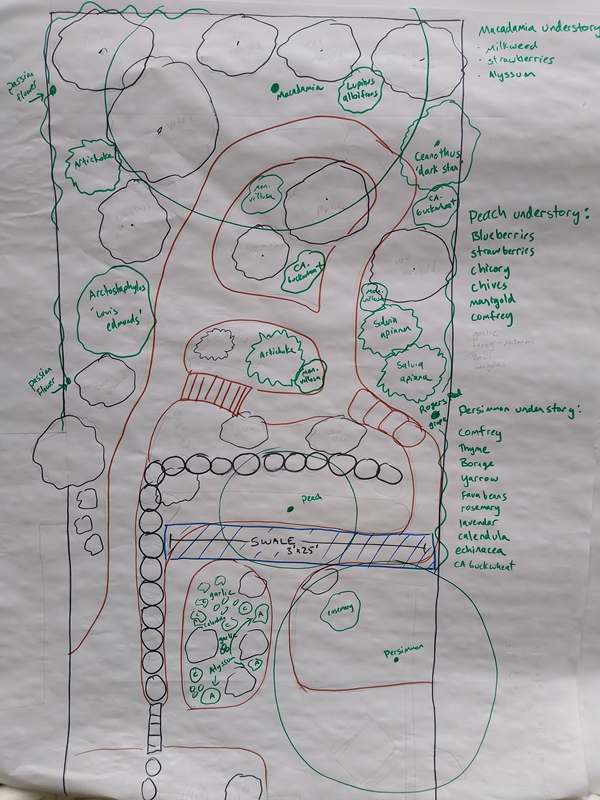Wild Cherry Way
Wild Cherry Way

Food Forest Keeper: Suzanne
For most of my childhood, my family lived in an apartment building in Chicago. I spent a lot of time looking out at the world from my bedroom window on the 20th floor. Despite that distance between me and the earth, I always had a great love of being in nature and a strong personal connection with the elements and creatures of the world. I especially loved spending time alone outside, observing and learning.
My formal study of plants and garden design began in San Francisco when I was in my 40s and discovered an organization called S.L.U.G. (San Francisco League of Urban Gardeners). They distributed compost containers, promoted community gardens and provided training on how to make compost.
After volunteering as a community composter for about six months, I signed up for their Green Gardener training program. By the time that ended, I was on fire for gardening! I wanted to learn more, so I continued my studies at San Francisco City College. I studied horticulture, native plants and ecology. Eventually, I changed careers and started working at a plant nursery. Later, I worked for some small landscaping design companies, while continuing my studies in horticulture and landscape design at Merritt College. I also had my own small maintenance business
in the East Bay for several years.
When I moved to Benicia a few years ago, I was excited to see that one of my neighbors had posted a sign that said her garden was a permaculture garden created by Sustainable Solano. I was very happy to find that I was living among like-minded people. Last year, after I went on the Sustainable Solano garden tour, I decided to apply for the opportunity to have a well-designed permaculture garden at my house
too.
Site Details
Installation Date:
February 2020
Size:
1,922 square feet
Sun Exposure:
8 hours
Soil:
Clay
Number of Swales:
1
Secondary Water:
Laundry-to-Landscape Greywater System
Rainwater
Roof water diverted to swales
Total annual water impact:
32,944 gallons
Design:

Designer: Lauren Bennett
Plant List:
Baker’s Manzanita, Blueberry (Sharp Blue, Jubilee, Reveille), California Lilac (Dark Star), Cleveland Sage, Coffeeberry, Lavender, Mexican Marigold, Rose, Rosemary, White Sage
Alyssum, Borage, California Buckwheat, California Poppy, Comfrey, Coyote Mint, Deargrass, Mugwort, Narrow Leaf Milkweed, Oregano, Plumbago, Purple Coneflower, Showy Milkweed, Thyme, Tree Collard
Chamomile, Strawberry
Garlic
Passionflower, Roger’s Red Grape
Installation:
Over a period of two months, on Saturdays, my yard was transformed. Sometimes, there were a dozen people at my house and on three Saturdays, there were more than 30 people! We completed three different phases of the work over that time.
At first, I met with a small group of students and a permaculture garden designer to discuss my vision and my wants for the garden. Once the design and plant list were complete, we invited a large group of interested volunteers to join in to dig swales, move plants, sheet mulch and put down compost. On one Saturday, we had a group of volunteers who learned how to install a laundry-to-landscape irrigation system. At the beginning of each large group session, there was a presentation about the philosophy and the science of the work that would be done that day.
When hearing about the plan for the two-month installation process, I was a little apprehensive. Since I’m a bit of a hermit, I wondered what it would be like to have so many people at my house. It turned out to be a wonderful experience! The people who came to the trainings all shared an interest in sustainable living. And, even though some people were experienced gardeners, while others were beginners, we found we had a lot in common. We had great conversations together, shared our knowledge, and made decisions together about many of the aspects of the installation.
It was a fun, energizing and educational experience. The public days, when there were 30 people working together, felt something like an old-fashioned barn raising. There was so much enthusiasm and comraderie, as we shared food and jokes and lots of hard work.
Vision for the Future:
My house is 160 years old. It’s one of the oldest houses in Benicia. When it was first built, it was a dairy farm and there are remnants of the cows’ stalls in the basement. Since it’s on the historical register, development of the property is limited, so the house and land have remained unchanged in many ways. Knowing about the house’s history has given me a strong sense of place. I recognize the privilege I have of being one of the guardians of this land.
When I moved to Benicia, it was with the intention of creating a sanctuary for myself and for the creatures that live on and around my property. I wanted to preserve a feeling of wildness in my yard. My goal was to make a safe, reliable resting place that would provide lots of opportunities to find food, water and habitat. I planted mostly low-water, low-maintenance plants, including many pollinator attractors and medicinal herbs. Eventually, I plan to invite small groups of children to my garden for fun and education.
Although parts of my garden were already well-established, the installation by Sustainable Solano took things to another level. My new garden has many complex layers of life. Before we started planting, the weeds were suppressed with cardboard and the soil was nourished with a thick layer of compost. We dug a deep swale to capture and store water underground. Many beautiful food-producing plants were added. Each new fruit tree was planted with a guild of supportive plants surrounding it, and I now have three sources of water: from the rooftop, from the laundry and from the irrigation valve.
A large area of my garden is shaded by a huge, old, wild cherry tree. Its branches droop so low that you can touch them when you walk by. The feeling of being sheltered and protected by the tree makes me think of it as the mother of my garden. The wild cherry supports so much life: squirrels, scrub jays, ravens, mourning doves, robins, bumblebees, hummingbirds and more all find food and shelter in its branches.
My wish is that my garden will become as nurturing as my cherry tree is by supporting an abundance of life, by providing shelter and food, and by offering beauty and peace to all those who visit.


